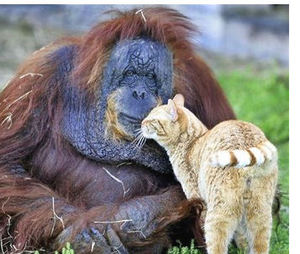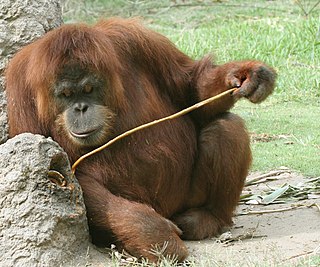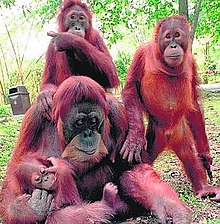
Orangutans are great apes native to the rainforests of Indonesia and Malaysia. They are now found only in parts of Borneo and Sumatra, but during the Pleistocene they ranged throughout Southeast Asia and South China. Classified in the genus Pongo, orangutans were originally considered to be one species. From 1996, they were divided into two species: the Bornean orangutan and the Sumatran orangutan. A third species, the Tapanuli orangutan, was identified definitively in 2017. The orangutans are the only surviving species of the subfamily Ponginae, which diverged genetically from the other hominids between 19.3 and 15.7 million years ago.

The Singapore Zoo, formerly known as the Singapore Zoological Gardens or Mandai Zoo, is a 28 hectares zoo located on the margins of Upper Seletar Reservoir within Singapore's heavily forested central catchment area. It is operated by the Mandai Wildlife Group, which also manages the neighbouring Night Safari, River Wonders, Bird Paradise as well as the forthcoming Rainforest Wild Park.

The Fort Wayne Children's Zoo is a zoo in Fort Wayne, Indiana, United States. Since opening in 1965, the 1,000-animal zoo has been located on 40 acres (16 ha) in Fort Wayne's Franke Park. The Fort Wayne Children’s Zoo is operated by the non-profit Fort Wayne Zoological Society under a cooperative agreement with the Fort Wayne Parks and Recreation Department. The zoo receives no tax funding for operations and operates solely on earned revenue and donations.

Perth Zoo is a 17-hectare (41-acre) zoological park in South Perth, Western Australia. The zoo first opened in 1898 and by 2011 housed 1258 animals of 164 species and an extensive botanical collection. It is a full institutional member of the Zoo and Aquarium Association (ZAA) and the World Association of Zoos and Aquariums (WAZA).

The Monkey World Ape Rescue Centre is a 65-acre (26.3 ha) ape and monkey sanctuary, rescue centre and primatarium near Wool, Dorset, England.

Adelaide Zoo is Australia's second oldest zoo, and it is operated on a non-profit basis. It is located in the parklands just north of the city centre of Adelaide, South Australia. It is administered by the Royal Zoological Society of South Australia Incorporated, which is a full institutional member of the Zoo and Aquarium Association and the World Association of Zoos and Aquariums, and which also administers the Monarto Safari Park near Murray Bridge.
Olivia Ong is a Singaporean singer and actress. Most of her works are in English, but she has recorded songs in Mandarin Chinese, Cantonese and Japanese. In her early career, she focused on singing jazz. Now she has moved on to Mandarin pop.

Ragunan Zoological Park, formerly and still commonly known as Ragunan Zoo, is a zoo located in the eponymous kelurahan (subdistrict) in Pasar Minggu, South Jakarta, Jakarta, Indonesia. The zoo has an area of 140-hectare (350-acre) and the largest park in Jakarta. The zoo has an aviary and a primate centre, and employs over 450 people. Many of the animals in the zoo are endangered and threatened from all parts of Indonesia and the rest of the world. There are a total of 2,288 animals inside the zoo. Laid out in a lush tropical habitat, rare animals such as crocodile, chimpanzee, gorilla, orangutan, tapir, anoa, sumatran tiger, babirusa, and peacocks are given ample room. The zoo is located in South Jakarta and is easily accessible through the Jakarta Outer Ring Road and TransJakarta Corridor 6 bus.

The Sumatran orangutan is one of the three species of orangutans. Critically endangered, and found only in the north of the Indonesian island of Sumatra, it is rarer than the Bornean orangutan but more common than the recently identified Tapanuli orangutan, also found in Sumatra. Its common name is based on two separate local words, orang 'people; person' and hutan 'forest', derived from Malay, and translates as 'person of the forest'.

The Bornean orangutan is a species of orangutan endemic to the island of Borneo. Together with the Sumatran orangutan and Tapanuli orangutan, it belongs to the only genus of great apes native to Asia. It is the largest of the three species of orangutans. Like the other great apes, orangutans are highly intelligent, displaying tool use and distinct cultural patterns in the wild. Orangutans share approximately 97% of their DNA with humans. Also called mias by the local population, the Bornean orangutan is a critically endangered species, with deforestation, palm oil plantations, and hunting posing a serious threat to its continued existence.
Orangutans have often attracted attention in popular culture. They are mentioned extensively in works of fiction and video games, while some captive individuals have drawn much attention in real life.

Inuka was a male polar bear and one of the mascots of the Singapore Zoo. Born and housed in a climate-controlled enclosure, he was the world's only "tropical polar bear".

Tonda was the oldest orangutan in the United States. Tonda died on March 23, 2009, at ZooWorld in Panama City Beach, Florida, aged 50.
Lone Drøscher Nielsen is a Danish wildlife conservationist who established the Nyaru Menteng Orangutan Reintroduction Project in Kalimantan, Borneo, Indonesia in 1998.

Gembira Loka Zoo is a zoological garden located in Yogyakarta, Special Region of Yogyakarta, Indonesia. Gembira Loka Zoo was opened in 1956 and comprises a botanical garden, orchid nursery, (artificial) lake, children's park, numerous scenic bridges across the Gajahwong River, and a collection of approximately 470 animals, most notable of which are its native Indonesian tigers, leopards, Komodo dragons, saltwater crocodiles, orangutans, and gibbons, as well as African animals such as lions, camels and hippopotamus. The park is 54 acres in size.

Karen is a Sumatran orangutan, who on 27 August 1994 at the San Diego Zoo was the first orangutan to have open heart surgery and in 2021 was among the first non-humans to receive a vaccine for COVID-19.

There are three species of orangutan. The Bornean orangutan, the most common, can be found in Kalimantan, Indonesia and Sarawak and Sabah in Malaysia. The Sumatran orangutan and the Tapanuli orangutan are both only found in Sumatra, Indonesia. The conservation status of all three of these species is critically endangered, according to the International Union for Conservation of Nature (IUCN) Red List.
Bernard Ming-Deh Harrison is a zoologist who was the executive director of the Singapore Zoo from 1981 to 2002.
Erni Suyanti Musabine is an Indonesian wildlife veterinarian. She works for the Wildlife Rescue Unit of the Indonesian Ministry of Environment and Forestry. Since 2007, her work has focused on the conservation and rescue of Sumatran tigers.















